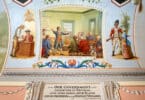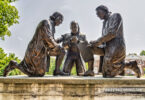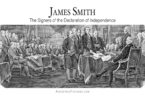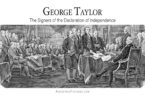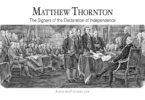Thomas Stone was born in 1743 in Charles County, Maryland at the family home of Poynton Manor. He was the second son in what was quite a large family, and he grew up with many siblings. His parents were David Stone and Elizabeth Jenifer. David was a descendant of William Stone, who had been governor of Maryland during the English Protectorate of Oliver Cromwell during the English Civil War.
As a child, Thomas showed a great aptitude for and interest in languages, as well as for learning in general. When he was fifteen years old, he was already a master of the English language, and wished to learn Latin and Greek, as well. Though his father was not fond of the idea, Thomas convinced him to allow him to attend a school ten miles away from his home, operated by a Scottish man named Mr. Blaizedel, to learn these languages. Thomas’s enthusiasm for learning these languages was so strong that he did not mind getting up at an unusually early hour to ride a horse the ten miles to the school, and arrived at school at its usual starting time with remarkable consistency.

After graduating from Mr. Blaizdel’s school, Thomas wished to study law. Though his father was a wealthy man, he did not pay his son’s way through his law studies, as he had a large family to support. So, Thomas had to borrow money to get him though his law studies. Thomas put himself under the tutelage and care of Thomas Johnson, who was a well-respected lawyer in Annapolis. After studying with Thomas Johnson, Thomas was admitted to the bar and entered into his own law practice in Fredericktown, Maryland. After practicing there for two years, Thomas moved to Charles County, Maryland, and entered into law practice there.

The law business he established in Fredericktown allowed him to discharge the debts he incurred while studying law. Thus financially secure, Thomas married at age twenty-eight to Margaret Brown, the daughter of a prominent local doctor named Gustavus Brown, who was said to be the wealthiest man in the county at that time. Margaret’s father gave Thomas one thousand pounds sterling upon his marriage to his daughter. Thomas used this money to buy a farm near the village of Port Tobacco. He, Margaret, and their three children (two daughters and a son) lived there during the American Revolution.
As revolutionary sentiment grew stronger in Maryland, Thomas joined the Charles County Committee of Correspondence. Thomas was a member of Maryland’s Annapolis Convention from 1774 to 1776. In 1775, Thomas was sent by the convention sent Thomas to the Continental Congress as a delegate from Maryland. Thomas was a popular delegate there among the people back home in Maryland, and as such, he was re-elected for several appointments to the Congress. Thomas was one of the ones who voted in favor of drafting a declaration of independence in May of 1776. This was despite the restrictions that the Maryland convention had imposed on its delegates to prevent them from supporting independence. This restriction was lifted in June of that year, after Thomas had already supported it.

Before voting in favor of drafting a declaration of independence, Thomas had been in favor of the colonies having open diplomatic relations with Great Britain so as to be able to not go to war, and have peaceful relations with them. This was because Thomas was a pacifist, and also a conservative who was reluctant to allow the colonies to take on the human and financial cost of a war.
The same year that Thomas signed the Declaration of Independence, the Congress assigned him to the committee that drafted the Articles of Confederation, which was to be the initial governing document of the new nation the Congress was building (though they did not know at the time that it would only be a temporary document that would later be replaced by a Constitution).
Thomas’s wife, Margaret, visited him in Philadelphia at this time, as his work on the Congress kept him away from home for long stretches of time, and she missed him. Unfortunately, there was a smallpox epidemic in Philadelphia at the time she visited. She received a smallpox inoculation upon arriving, but she had an adverse reaction to it which caused her health to decline for the rest of her life. Therefore, after signing the Declaration of Independence, Thomas took Margaret home. After this, he stayed away from the Congress, devoting his time to caring for Margaret and their children, except for a brief time in 1784, when the meetings of the Continental Congress were temporarily held in Annapolis, Maryland, which was close to where he lived, meaning he could go home to Margaret every day after Congress adjourned for the evening.
Thomas stayed in Maryland with Margaret, accepting election to the Maryland Senate from 1779 to 1785. While in the Senate in Maryland, Thomas promoted the Articles of Confederation, which Maryland became the last state to approve. In spite of continuing his political activities, Thomas gave up his law practice to devote more of his time to caring for Margaret. The more Margaret’s health declined, the more Thomas withdrew from public life altogether. Margaret crossed to the other side in 1787 at approximately thirty-eight years old. Thomas, who was devoted to her, became depressed, and crossed to the other side himself only four months after her, supposedly of a broken heart. Thomas and Margaret’s children were all teenagers when they lost both of their parents. Thomas was buried at his plantation home, which still stands today and can be visited.
Thomas’s house and plantation stayed in his family for five generations. In 1936, it was sold in a private purchase. The primary structure of the home was severely damaged by fire in 1977. After this, the National Park Service purchased the property and restored it to its original appearance. It was opened to the public in 1997 as the Thomas Stone National Historic Site, and is owned and operated by the National Park Service. The house and museum is located in Port Tobacco Village, Maryland.


